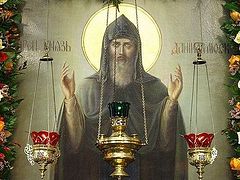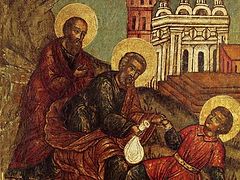 The Holy Hierarch Peter of Moscow. Artist: D. Kostylev
The Holy Hierarch Peter of Moscow. Artist: D. Kostylev
The future Metropolitan of All Russia was born in Volyn (in the western part of today’s Ukraine) in the family of pious and religious parents. At the tender age of twelve, young Peter entered a monastery and took monastic vows. He learned to paint icons and shared them as gifts with his brethren and the pilgrims.
For his virtuous life of an ascetic and zealous attitude toward his monastic obedience, the abbot of the monastery decided to ordain the pious monk as a hieromonk. After many years of ascetic labors at his monastery, the hieromonk Peter sought his abbot’s blessing to leave the monastery. Once he received that blessing, the future metropolitan abandoned his monastery, and in search of a secluded location to continue his monastic exploits, he arrived at the bank of the Rat’ River where he built a small cell. Soon after that, a monastery grew on the site of the secret spiritual labors of hieromonk Peter, and he was elected its abbot.
News of the ascetic abbot spread far beyond his monastery. Prince Yuri Lvovich of Galicia would often visit the monastery to receive spiritual edification from the holy ascetic. While he was an abbot, the Holy Hierarch Peter painted an icon of the Mother of God, unlike any other. It was called after the author’s name, the Petrovskaya Icon of the Mother of God.
One day, Metropolitan Maximus of Vladimir, who traveled the lands of Rus’ with words of instruction and edification, visited the monastery. Having received the blessing of the holy hierarch, abbot Peter presented the Petrovskaya Icon of the Most Holy Mother of God, that he had painted, to the metropolitan.
When Metropolitan Maximus died, the Vladimir cathedra remained unoccupied for some time. The Holy Great Prince Michael of Tver, who ruled in Vladimir at the time, sent abbot Gerontius, his associate and kindred soul, to the patriarch of Constantinople to receive his blessing to install Gerontius as the head of the Russian Metropolis. Gerontius carried with him in his travels the icon of the Mother of God that belonged to Metropolitan Maximus. On the advice of Prince Yuri of Galicia, abbot Peter also went to the Patriarch of Constantinople to accept the Vladimir cathedra. God chose St. Peter to nourish the Russian Church. The Mother of God appeared to Gerontius as he was sailing the Black Sea on a stormy night and announced: “You labor in vain, for you will not be a bishop. He who painted My icon, Abbot Peter of Rat’, will be enthroned in the Russian Metropolia.” The words of the Mother of God were fulfilled to the word: Patriarch Athanasius of Constantinople (1289–1293) with his council elevated St. Peter as Metropolitan of Russia, bestowing upon him the hierarchical vestments, the staff, and the icon brought by Gerontius.
 St. Peter the Metropolitan of Moscow Upon his return to Russia in 1308, Metropolitan Peter remained in Kiev1 for a year and then moved to Vladimir. Russia at that time was going through struggle for the grand dukedom between Michael of Tver and Yuri of Moscow. St. Peter took the side of the latter, as a consequence of which he was accused before the Patriarch by the Bishop Andrew of Tver. In 1311, a Church council was convened in Pereyaslavl that recognized Bishop Andrey's accusation as slander.
St. Peter the Metropolitan of Moscow Upon his return to Russia in 1308, Metropolitan Peter remained in Kiev1 for a year and then moved to Vladimir. Russia at that time was going through struggle for the grand dukedom between Michael of Tver and Yuri of Moscow. St. Peter took the side of the latter, as a consequence of which he was accused before the Patriarch by the Bishop Andrew of Tver. In 1311, a Church council was convened in Pereyaslavl that recognized Bishop Andrey's accusation as slander.
The primate experienced many difficulties in the first years of his rule as the Metropolitan of Rus’. The Russian land suffered from lack of established order under the Tatar yoke, and St. Peter often had to move from place to place. During his never-ending visits to the dioceses, he tirelessly taught the people and the clergy in the strict observance of Christian piety, and urged the warring princes to seek peace and unity.
In 1313, when Uzbek became khan (the first khan to embrace Islam), St. Peter traveled to the Horde. He was received there with honor and released with a new khan’s decree. This decree confirmed all the former privileges of the clergy and allowed a new one—all churchmen in all cases, including criminal ones, were subject to the Ecclesiastical court.
When, following the death of the Princes Michael of Tver and Yuri of Moscow, Prince Alexander Mikhailovich of Tver received a decree of grand dukedom from the khan and entered the struggle with Ivan Danilovich (Kalita) of Moscow, Metropolitan Peter took Ivan Kalita's side.
Seven hundred years ago, the future golden-domed capital was still a small settlement inside the Kremlin walls, but even then it was known as a noisy and crowded place
In his travels around Rus, the Holy Hierarch returned to Moscow over and over again. Seven hundred years ago, the future golden-domed capital was still a small village within the walls of the modern Kremlin, but even then it was already a noisy and crowded place. Metropolitan Peter needed a place to pray in seclusion. Such a place was found: the elevated bank of the Neglinnaya River not far from the Kremlin in the small village of Vysokoye, located deep inside the woods. It reminded Metropolitan Peter of the monastery on the bank of the river Rat’ where he was abbot. This place became the site of the future Vysoko-Petrovsky stavropegial monastery.2 The Holy Hierarch Peter erected a wooden church in the name of the Holy Chief of the Apostles Peter—his heavenly patron—and Paul, and the monastery was originally known as Petropavlovsky monastery (so called even three hundred years later, after the second consecration of its main cathedral, but already in honor of the Holy Hierarch Peter himself).
As he was praying for the fate of Rus’, Metropolitan Peter grew more and more convinced about the transfer of the metropolitan cathedra from Vladimir to Moscow. The final move took place in 1325. The prince built a “vast” court for the holy hierarch in the eastern part of the Kremlin, however Metropolitan Peter still preferred to stay in the small monastery he had founded. A convenient, wide road was laid through the woods, leading from the monastery to the Kremlin, and known as Petrovka to this day.
St. Peter predicted the liberation from the Tatar yoke and the future rise of Moscow as the center of all Russia. On his advice, Grand Prince Ivan Danilovich Kalita laid the first stone church in Moscow on August 4, 1326, in the name of the Dormition of the Most Holy Mother of God. The saint said to the great prince, “If you comfort my old age and erect here the temple to the Mother of God, then you will be more glorious than all other princes and your kin will increase, and I will rest with my bones in this city, and the hierarchs will strive to reside here, and its enemies will be defeated.” The holy metropolitan built his stone coffin with his own hands in the wall of this temple and wished to see its construction completed. But the Dormition Church was only consecrated after his death on August 4, 1327.
 At the relics of the Holy Hierarch Peter in the Dormition Cathedral of the city of Moscow. Photo credit: S. Vlasov/Patriarchia.Ru
At the relics of the Holy Hierarch Peter in the Dormition Cathedral of the city of Moscow. Photo credit: S. Vlasov/Patriarchia.Ru
Metropolitan Peter made Moscow a place of his High Primatial labors. Owing to this, it became the spiritual center of Rus
Metropolitan Peter's move to Moscow and the erection on his advice of the Dormition Cathedral in the Kremlin, which became not only the burial place of the primate of the Russian Orthodox Church, but also the main cathedral of reawakened Russia following the Tatar invasion, contributed, just as the Holy Hierarch had predicted, to the unification of the Russian lands around Moscow. Due to the fact that he made Moscow the place of his primatial labors, it became the spiritual center of Russia and the capital of the Russian dominion.
On December 21, 1326, Metropolitan Peter departed unto the Lord. The holy body of the primate of the Church was buried in the Dormition Cathedral in the stone coffin prepared by the holy hierarch himself.
Many miracles happened through the prayers of the God-pleasing saint. Many healings took place in secret that testified to the Holy Hierarch’s deep humility even after death. From the day of the repose of the primate of the Russian Church, profound veneration of him as a saint became firmly established and spread all over the Russian land. As early as 1327, a mere six months after his death, Metropolitan Peter was glorified as a saint by the Council of Russian Bishops in Vladimir. Thirteen years later, in 1339, under the Holy Patriarch Theognostos, he was glorified as a saint by the Council in Constantinople.
The Holy Hierarch Peter became the first canonized Moscow saint. The Primates of the Russian Church were called and selected at his tomb
Thus, St. Peter became the first canonized Moscow saint. It was at his tomb where the princes venerated the cross as a sign of loyalty to the Grand Duke of Moscow. As a highly revered patron of Moscow, Metropolitan Peter was called to witness at the time of drawing up state treaties. The Novgorodians, who had the right to elect their own bishops at St. Sophia, once they joined Moscow under John III, had pledged to install their archbishops only at the tomb of St. Peter the Wonderworker, where the primates of the Russian Church were called and selected.
The Russian chronicles repeatedly mentioned St. Peter, since not a single major state endeavor took place without a prayer at his tomb.
The transfer of the relics of the venerable Metropolitan took place in 1472 and 1479. In memory of this event, two feasts have been established on October 5/18 and August 24/September 6.




